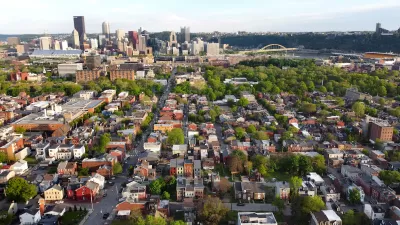Note: This column was originally titled, "A Stupid Attack on Smart Growth," intended as a pun on 'smart' and 'stupid.' However, that sounds harsh so I retitled it. - T.L. The National Association of Home Builders (NAHB) has a well-financed campaign to discourage communities from considering smart growth as a possible way to conserve energy and reduce pollution emissions. They contend that compact development has little effect on travel activity and so provides minimal benefits. The NAHB states that, “The existing body of research demonstrates no clear link between residential land use and GHG emissions.” But their research actually found the opposite: it indicates that smart growth policies can have significant impacts on travel activity and emissions.
Note: This column was originally titled, "A Stupid Attack on Smart Growth," intended as a pun on 'smart' and 'stupid.' However, that sounds harsh so I retitled it. - T.L.
The National Association of Home Builders (NAHB) has a well-financed campaign to discourage communities from considering smart growth as a possible way to conserve energy and reduce pollution emissions. They contend that compact development has little effect on travel activity and so provides minimal benefits. The NAHB states that, "The existing body of research demonstrates no clear link between residential land use and GHG emissions." But their research actually found the opposite: it indicates that smart growth policies can have significant impacts on travel activity and emissions.
My new report, Critique of the National Association of Home Builders' Research On Land Use Emission Reduction Impacts, examines the NAHB's claims. Their campaign misrepresents key issues and significantly understates smart growth's potential impacts and benefits. Actual travel impacts are probably four to eight times greater than the NAHB implies (doubling all land use factors typically reduces affected residents' vehicle travel 20-40%, compared with the 5% they claim), and total benefits are far greater due to co-benefits the study ignores, including more cost-effective public infrastructure, household transportation cost savings, and various safety and health benefits.
The NAHB's campaign responds to recent studies which indicate that smart growth policies can provide significant energy savings, emission reductions, and other benefits, such as the U.S. Department of Transportation's Transportation's Role in Reducing U.S. Greenhouse Gas Emissions: Report to Congress, the Transportation Research Board's Driving and the Built Environment: The Effects of Compact Development on Motorized Travel, Energy Use, and CO2 Emissions, and the Urban Land Institute's Land Use and Driving: The Role Compact Development Can Play in Reducing Greenhouse Gas Emissions. These studies indicate that residents of compact, multi-modal communities typically drive 20-40% less than they would in conventional, automobile-dependent communities, so implementing smart growth policies now can reduce future transport fuel consumption and emissions 5-15%, and provide other benefits.
The National Home Builders Association (NHBA) commissioned five studies that critically examined how land use affects emissions, which they summarize in a report, Climate Change, Density and Development: Better Understanding the Effects of Our Choices. It claims that "The existing body of research demonstrates no clear link between residential land use and GHG emissions and leaves tremendous uncertainty as to the interplay of these factors," and "The assumption of a causal connection between density and GHG emissions is based on prevailing beliefs within the planning community and not on verifiable scientific research or analysis." This is an inaccurate summary of their own research:
- It presents the most negative results. Most research does not support the NAHB's conclusions that there is no clear link between residential land use and emissions. More recent, statistically sophisticated studies tend to show stronger relationships than older, simpler studies.
- It confuses the concepts of density and compact development. It argues that the relatively small travel reductions caused by increased density (holding all other factors constant) means that compact development (a set of land use factors that includes increased land use density, mix, connectivity and modal diversity) has minimal impacts and benefits.
- It overlooked some of the most recent, statistically sophisticated research which indicates a strong relationship between land use and transport.
- It reports the smallest impacts rather than the full range of values. It claims that the elasticity of vehicle travel with respect to density is only -0.05 (increasing density 10% only reduces vehicle travel 0.5%), although most current research indicates impacts two to four times greater.
- It highlights the incremental costs of compact development but overlooks significant co-benefits including infrastructure cost savings, consumer savings, improved public safety and health, and habitat preservation.
Most of the NAHB's research is good, professional analysis. I particularly appreciated insights in the Abt Associates report, and the research by Helen Fei Liu which measured how various factors affect travel activity in urban regions. Of the five studies, Portland State University Professor Eric Fruits' literature review is most negative, and the one the NAHB cites most. Fruits argues there is little evidence that land use policy reforms can reduce climate change emissions and concludes, "regional efforts to slow potential climate change through compact development are little more than showy, but costly, curiosities." Last year, Fruits published a summary article, Compact Development And Greenhouse Gas Emissions: A Review Of Recent Research, in the Center for Real Estate Quarterly Journal which he edits.
I doubt that Fruits' article would pass normal peer review because it contains critical errors and omissions. For example, it states that "some studies have found that more compact development is associated with greater vehicle-miles traveled" citing a fifteen-year-old article, Cars And Drivers In The New Suburbs: Linking Access To Travel In Neotraditional Planning. This completely misrepresents that study, which only presented theoretical analysis indicating that grid street systems may under some conditions increase vehicle travel compared with hierarchical street systems. Subsequent research by Ewing and Cervero and the California Air Resources Board indicate that, in fact, roadway connectivity is one of the most important land use factors affecting vehicle travel. Fruit's article contains other important omissions described in my report.
To his credit, Fruits did allow me to publish a response article, Can Smart Growth Policies Conserve Energy and Reduce Emissions?, in a subsequent issue of the Journal.
The NAHB's campaign is misguided. Residential developers actually have good reasons to support smart growth policies. Current demographic and economic trends are increasing demand for more compact, multi-modal development, and the vehicle and utility savings that result can leave households with more money to spend on housing, which reduces housing foreclosure risks.
What do you think? Is my criticism of the NAHB's claims justified? Have I missed something?
For more information
CARB (2010-2011), Research on Impacts of Transportation and Land Use-Related Policies, California Air Resources Board (http://arb.ca.gov/cc/sb375/policies/policies.htm).
Michael Dudley (2010), Planning for "Dickensian Gloom"? Refuting Critics of Smart Growth (Again), Planetizen Blog (www.planetizen.com); at www.planetizen.com/node/42679.
Reid Ewing and Robert Cervero (2010), "Travel and the Built Environment: A Meta-Analysis," Journal of the American Planning Association, Vol. 76, No. 3, Summer, pp. 265-294; at www.climateplanca.org/Travel_Built_Environ.pdf.
Eric Fruits (2011), "Compact Development And Greenhouse Gas Emissions: A Review Of Recent Research," Center for Real Estate Quarterly Journal, Vol. 5, No. 1. Winter; at www.pdx.edu/sites/www.pdx.edu.realestate/files/media_assets/quarterly_report/march_2011/01%20Fruits%20Quarterly%202011-02.pdf.
Todd Litman (2011), Evaluating Criticism of Smart Growth, VTPI (www.vtpi.org); at www.vtpi.org/sgcritics.pdf.
Todd Litman (2011), "Can Smart Growth Policies Conserve Energy and Reduce Emissions?" Portland State University's Center for Real Estate Quarterly (www.pdx.edu/realestate/research_quarterly.html),Vol. 5, No. 2, Spring, pp. 21-30; at www.vtpi.org/REQJ.pdf.
Todd Litman (2011), Critique of the National Association of Home Builders' Research On Land Use Emission Reduction Impacts, Victoria Transport Policy Institute (www.vtpi.org); at www.vtpi.org/NAHBcritique.pdf.
NHBA (2010), Climate Change, Density and Development: Better Understanding the Effects of Our Choices, National Home Builders Association (www.nahb.org); at www.nahb.org/reference_list.aspx?sectionID=2003.
TRB (2009), Driving and the Built Environment: The Effects of Compact Development on Motorized Travel, Energy Use, and CO2 Emissions, Special Report 298, Transportation Research Board (www.trb.org);at http://onlinepubs.trb.org/Onlinepubs/sr/sr298.pdf.
ULI (2010), Land Use and Driving: The Role Compact Development Can Play in Reducing Greenhouse Gas Emissions, Urban Land Institute (www.uli.org); at www.uli.org/ResearchAndPublications/PolicyPracticePriorityAreas/Infrastructure.aspx.
USDOT (2010), Transportation's Role in Reducing U.S. Greenhouse Gas Emissions: Report to Congress, U.S. Department of Transportation (www.dot.gov), at http://ntl.bts.gov/lib/32000/32700/32779/DOT_Climate_Change_Report_-_April_2010_-_Volume_1_and_2.pdf.

Maui's Vacation Rental Debate Turns Ugly
Verbal attacks, misinformation campaigns and fistfights plague a high-stakes debate to convert thousands of vacation rentals into long-term housing.

Planetizen Federal Action Tracker
A weekly monitor of how Trump’s orders and actions are impacting planners and planning in America.

In Urban Planning, AI Prompting Could be the New Design Thinking
Creativity has long been key to great urban design. What if we see AI as our new creative partner?

King County Supportive Housing Program Offers Hope for Unhoused Residents
The county is taking a ‘Housing First’ approach that prioritizes getting people into housing, then offering wraparound supportive services.

Researchers Use AI to Get Clearer Picture of US Housing
Analysts are using artificial intelligence to supercharge their research by allowing them to comb through data faster. Though these AI tools can be error prone, they save time and housing researchers are optimistic about the future.

Making Shared Micromobility More Inclusive
Cities and shared mobility system operators can do more to include people with disabilities in planning and operations, per a new report.
Urban Design for Planners 1: Software Tools
This six-course series explores essential urban design concepts using open source software and equips planners with the tools they need to participate fully in the urban design process.
Planning for Universal Design
Learn the tools for implementing Universal Design in planning regulations.
planning NEXT
Appalachian Highlands Housing Partners
Mpact (founded as Rail~Volution)
City of Camden Redevelopment Agency
City of Astoria
City of Portland
City of Laramie






























